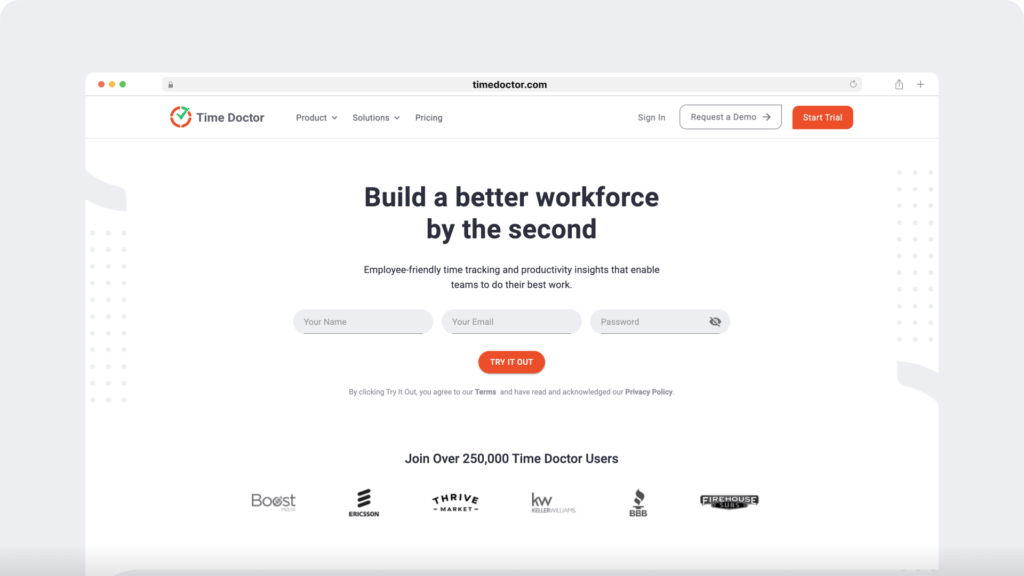There’s no doubt that managing time efficiently is crucial to success.
However, you need to understand how and where you spend your time.
How do you do that?
By using time management systems!
Time management systems can help you minimize wasted time, increase productivity, and unlock your full potential to accomplish daily goals.
In this article, we’ll highlight 10 great time management systems and discuss how they work. We’ll also explore why you should use a time management system and how you can combine it with software solutions for better control over your time.
Table of Contents
- 10 best time management systems
- 4 reasons you need time management systems
- Manage time with Time Doctor
Let’s get started!
10 best time management systems
Here are the best time management systems to help you beat procrastination and enhance your performance:
1. Eisenhower Matrix
The Eisenhower Matrix is a time management system that divides tasks based on their importance.
You divide your tasks into four quadrants for effective time management:
| Urgent | Not Urgent | |
| Important | Quadrant 1 It includes tasks with approaching deadlines that you should do immediately without delay. | Quadrant 2 It includes tasks of secondary importance that you can schedule for a later date on your Google Calendar. |
| Not Important | Quadrant 3 It includes tasks that don’t require your involvement and you can delegate them to your junior employee. | Quadrant 4 It includes tasks that you should eliminate to use your work time more judiciously. |
Based on this template, you can decide which tasks need your immediate attention and which tasks can be postponed or delegated, or eliminated for the time being.
This time management system is quite useful when you’re swamped with multiple project management tasks, and it’s hard to identify what’s urgent. It helps you quickly sort your action items and tackle each task in order of priority.
2. Getting Things Done (GTD)
Getting Things Done is a time management system that emerged from the book by David Allen, Getting Things Done: The Art of Stress-Free Productivity.
Using this time management tool can help you get the essential tasks out of your head onto a notepad to understand better what needs to be done and when.
The five essential steps to Getting Things Done are:
- Capture: List all your crucial to-dos and project management tasks for easy tracking.
- Clarify: Go over your to-do list and identify any task you should remove or postpone.
- Organize: Categorize your tasks into different lists of work priority. Add due dates, so you never skip the deadlines.
- Reflect: Keep revisiting your task list and figure out the upcoming steps and subtasks for each task.
- Engage: Refer to this to-do list every day for tracking your work progress and getting more things done during your work hours.
3. Time blocking
The time blocking system helps you improve work focus — you block certain hours of your day to perform specific tasks.
Here’s how you can implement the time blocking method for better task management:
- Step 1: Make a task list and highlight any repetitive tasks that you can automate.
- Step 2: Estimate the time you need to dedicate to each task.
- Step 3: Keep some time aside for emergencies like sickness, downtime, hardware malfunctioning, etc.
- Step 4: If you still have any free time on your hand, use it to complete any of your pending tasks.
You can use Google Calendar or any other calendar app to block your work time for tasks or meetings and stay in control of your work schedule.
For effective time management, you can combine it with a time management app to track the exact time for each task and not spend more hours than you planned to.
Read everything about time blocking and how it works.
4. Autofocus
Autofocus is a technique to help you make faster work decisions and execute tasks based on your motivation. It allows you to perform tasks that you’re more inclined to do than others. This way, it keeps you engaged in finishing your task list with the least amount of struggle.
Here’s how you can use the Autofocus technique for successful project management:
- Step 1: Note down all the big or small tasks you have.
- Step 2: Carefully go through the tasks and choose the one that comes across as exciting or enjoyable.
- Step 3: Keep working on the task for an hour or more and check it off the list on completion.
- Step 4: Each time you finish a task, repeat the process from Step 2.
- Step 5: Highlight the remaining tasks at the end of the workday and re-start the next day.
5. Iceberg Method
The Iceberg Method lets you collate important notes and resources as and when you come across them. This information may prove valuable for your future projects and save you additional time in research.
This time management technique helps you build a repository of research material that acts as a knowledge base for any task you may take up later.
Here’s how business owners can implement the Iceberg Method for better employee time management:
- Step 1: Save any work-related email, quote, article, video link, or PDF that may come in handy later.
- Step 2: Organize these resources using specific tags and folders for easy access.
- Step 3: Go through all the information in your knowledge base every four to six weeks to check if any material can prove helpful for your current tasks.

6. Pomodoro technique
Pomodoro is a popular time management technique that recommends 25 minutes of super-focused work followed by a 5 minute break. It minimizes the chances of burnout by allowing intermittent breaks throughout the workday.
Here’s how you can deploy the Pomodoro technique for efficient use of your work time:
- Step 1: Choose a task and work on it uninterruptedly for 25 minutes.
- Step 2: When the time management software indicates the end of 25 minutes, take a 5-minute break to stretch and unwind.
- Step 3: Continue working with absolute focus again for another 25 minutes, followed by a 5-minute break. You can reward yourself by extending the break time of every fourth break by 15-30 minutes.
You can integrate your project management software with simple time tracking tools to follow the Pomodoro technique rigorously.
7. Agile Results
With Agile Results, you can identify any three tasks that you hope to achieve by the end of the day, week, month, and year. It allows you to manage work in small chunks, which isn’t too overwhelming.
Here are the four key features of Agile Results that can help you get better control of your life and time:
- Monday vision: Each Monday, note down three results you’d like to accomplish before the weekend and start working on that goal.
- Daily wins: Every day, identify three important tasks you’d like to complete before the day ends.
- Friday reflection: Review your work timesheet on the time tracker app on Friday. Analyze existing work processes to note three things going well and three things that require improvement.
- Hot spots: Apart from figuring out the three daily and weekly tasks, you should invest your time in identifying pain points (low revenue, client dissatisfaction, etc.) and other big picture tasks related to your business.
8. Kanban system
If you’re tracking multiple projects with dynamic timelines, then the Kanban system can help you see things through. It can help you visualize tasks and determine stages of work progress.
Today the Kanban system is integral to several task management and time tracking apps like Asana, Trello, Toggl Track, Microsoft Project, etc.
Here’s how you can use the Kanban system to boost employee time management:
- Step 1: List your tasks in a visual format (online or on paper). Mark the ones you want to tackle first and others that you can take up later.
- Step 2: Figure out the time you’ll have to spend on each task, depending on the difficulty level.
- Step 3: Create a Kanban board with three columns: tasks to be done, tasks in progress, and tasks completed.
- Step 4: Don’t have more than three tasks under the ‘tasks in progress’ column to avoid stress and tackle one task at a time.
9. Bullet Journal
Bullet Journal is a daily note-taking system to organize all your task-related information. It uses various symbols for task entries so you can quickly identify whether a task is completed, postponed, or removed.
Here’s how you can implement the Bullet Journal system:
- Step 1: To start with, you’ll need a journal with page numbers. Add a work-relevant title to every page.
- Step 2: Under every title, you can list out specific tasks (represented by •), events (represented by ◦), and notes (represented by –).
- Step 3: Depending upon the task status, mark them as completed (X), migrated (>), postponed (<), or eliminated (•).
- Step 4: Add signifiers to give your bullets more context. For example, an asterisk (*) denotes a priority, while an exclamation point (!) denotes inspiration.
- Step 5: Create collections to organize specific types of entries.
10. Time tracking
Time tracking is easy to execute and can improve employee efficiency. It essentially allows you to track time spent on different tasks and projects to know where most employee time is spent.
You can use any time tracking app for managing employee performance and identifying areas of improvement. Additionally, it can assist you in calculating billable hours, tracking attendance, and processing payroll.
Here’s how you can use the time management software for employee time tracking:
- Step 1: Track time for all the tasks you perform during work hours, be it as a project manager, employee, or freelancer.
- Step 2: Assess your timesheet on time tracking apps to identify time-consuming tasks and figure out a different approach to fastrack them.
- Step 3: Implement those processes and check if the work time has come down or gone up for the same tasks on time tracking app.
Now that we know the different types of time management systems out there, let’s understand why we need to have a time tracking system in the first place.
4 reasons you need time management systems
Here’s why you should consider implementing time management systems in your organization:
1. To deliver quality work on time
Time management systems help you create a framework in which you’re aware of your tasks for the particular day or even the entire week. It means that you don’t waste time deliberating over what to work on and what to leave out on any specific workday.
By establishing such a planned work schedule, you can avoid the last-minute stress of not meeting any work goal. This way, a time management system ensures the best business outcomes and improves overall work quality.
2. To improve employee productivity
Encouraging employees to adopt a time management system can help them prioritize urgent tasks and minimize distractions. Additionally, they can avoid working overtime on weekends by sorting out all the high-level tasks on time.
It boosts employees’ personal productivity and makes them better at task management.
3. To reduce workplace stress
Employees often procrastinate or spend too much time on tasks that may be delegated or even deleted.
In the long run, this sort of poor time management can bring about stress as you’re left with too little time to wrap up urgent tasks.
However, time management systems can guide your employees in the right direction through list-making, progress tracking, and eliminating time-consuming processes.
It also helps them strike the perfect work-life balance, so work problems do not constantly preoccupy them even outside their work hours.
4. To streamline business workflow
When every team member sticks to a fixed time frame and work schedule, they can collaborate better among themselves. It’s because they have a rough idea of how much is achievable within a particular time.
So teammates can communicate their deadlines among themselves, set up work dependencies accordingly, and streamline the internal workflow.
But are time management systems enough on their own for employee time tracking and boosted productivity?
Manage time with Time Doctor
To take your organizational performance to the next level, you need to integrate your chosen time management system with robust time tracking apps.
Time management software can help you optimize work processes and analyze real-time employee performance.
And that’s where the Time Doctor app comes in.
What’s Time Doctor?

Time Doctor is a powerful attendance tracking and performance management app that helps measure employee efficiency. Used by large enterprises like Ericsson, as well as by small businesses, like Thrive Market, Time Doctor is the perfect employee management tool for any business.
Here are some of the key features of this time tracking software:
- Offers manual and automatic time tracking features on the desktop, tablet, and mobile device.
- Generates productivity reports that give you insight into employee performance.
- Lets you create work schedules and track employee attendance.
- Helps you assign tasks and projects to employees.
- Integrates with Paypal, Wise, and Gusto for invoice and payroll management.
Wrapping up
Time management is an underrated skill that can help you stay calm and keep workplace chaos at bay.
You can use the methods we’ve discussed in this article to improve your time management skills.
And besides adopting a time management system, you can opt for a time tracking app like Time Doctor to help you improve employee productivity and create perfect work schedules.
So why not sign up for Time Doctor’s 14-day free trial and experience its time tracking benefits yourself?

Vaishali Badgujar is a Content and SEO specialist at Time Doctor, an employee-friendly time-tracking system that boosts productivity.


